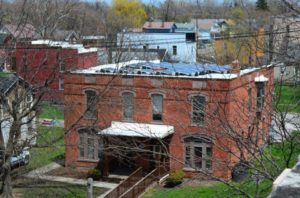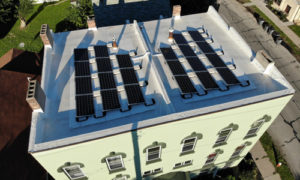Blog
Tagged In: Clean Energy
Glass City Community Solar Brings Clean Energy to Low-Income Neighborhoods
Ohio Environmental Council, April 15, 2020
As the climate action movement progresses, the renewable energy industry grows more and more competitive. Solar and wind energy is cheaper to produce now than ever before, but is access to the benefits of clean energy actually equitable?
Low-income residents and communities of color are most affected by the fossil fuel energy economy and usually find it difficult to tap into the benefits of renewable energy–most notably, the cost savings from rooftop or community solar and the ability to participate directly in the clean energy economy. It’s these same families and individuals who are also most disproportionately impacted by the negative effects of climate change and have the most to gain from a transition to affordable clean energy.

Toledo, known as the Glass City, was built on the industrial production of auto glass and glass bottles in the early 1900s; in recent decades, Toledo has become a pioneer in photovoltaic innovation and the technology used in the production of solar panels. And since 2017, Glass City Community Solar (GCCS) has been working to identify new, innovative ways to bring solar energy to low-income neighborhoods in Toledo, Ohio.
In 2017, a team of University of Toledo engineering students competed in the U.S. Department of Energy’s SunShot Initiative, the Solar in Your Community Challenge, joining more than 150 teams across the country developing new replicable strategies to make solar energy more cost-competitive and accessible to low-to-moderate income community members. Out of that friendly competition, a new Toledo-based non-profit, Glass City Community Solar (GCCS), was formed.
While receiving the $50,000 incubation grant over the 18 month competition, the team of engineering students, community partners and local stakeholders developed a plan to help bring clean energy options to low-income Toledo neighborhoods by investing in rooftop solar installations on affordable housing projects, While expanding access to the benefits of solar for low-income residents in the Toledo area, the team also seeks to improve education, training, and employment opportunities in solar development and installation for low-income individuals and communities of color. Not only do the solar panels help reduce energy costs, increase economic efficiency, and reduce greenhouse emissions, but this community-wide investment helps introduce low-income residents to career and training opportunities in the clean energy economy.
“Access to renewable energy options for low-income residents is extremely limited” says Dr. Randall Ellingson, professor of physics at University of Toledo and Glass City Community Solar (GCCS) founding-member. “Because of the high initial cost of installing solar, low-income residents have no real access to the benefits. Everyone should have access to clean, affordable energy. But it’s not enough to just make clean energy more accessible for low-income residents, we want to try to open new opportunities to access careers in the clean energy economy as well.”

Working with property managers, property owners, and the U.S. Department of Housing and Urban Development, GCCS has targeted low-income affordable housing projects to design and construct rooftop solar installations. Private donors fund the construction and installation of the array through a power purchase agreement, and after five years the array is donated to GCCS. Just two years later, 225 kilowatts of solar energy provides electricity to 220 low-income residential units. And next month, GCCS will begin construction on another 47 kilowatt solar array in the Vistula neighborhood near downtown Toledo. The newest array has been supported by generous donations of at least $20,000 each from a private donor in Washington state, the Toledo Community Foundation’s Aristides Capital Charitable Fund, and The Left Coast Fund’s Solar Moonshot Project. By the end of 2020, over 250 low-income Toledo residents will receive their electricity from clean, carbon-free solar energy thanks to the work of GCCS!
These new clean energy investments are now delivering immediate carbon-reduction benefits that are helping to improve the health and well-being of low-income residents that are most impacted by our fossil fuel economy. Not only is this investment by GCCS helping to give low-income residents a stake in the clean energy economy, but it will help to increase the political will needed for continued clean energy investment and climate progress at all levels of government.
If you, too, would like to help make access to clean energy options more equitable in Ohio, contribute to Glass City Community Solar! Visit [link]. (http://glasscitycommunitysolar.org/)